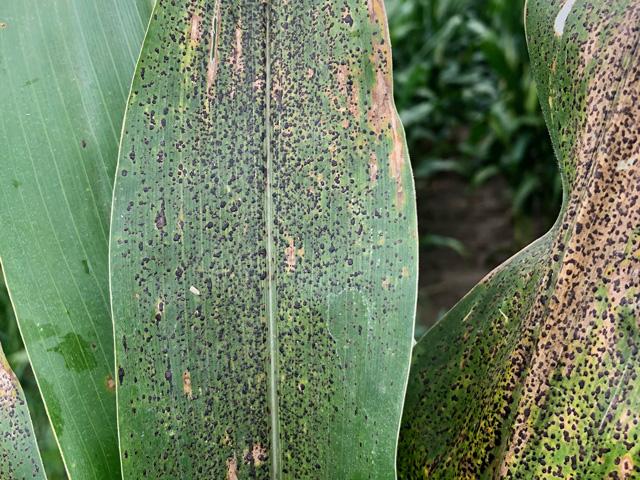Time to Scout for Tar Spot
Early Detection of Tar Spot Can Help Prevent Corn Yield Loss
Editor's Note: This article was originally posted on Friday, July 8. It was reposted on Tuesday, July 12, with a link to a DTN video of Alison Robertson, an Iowa State University Extension plant pathologist, talking about the early arrival of tar spot in the Corn Belt and scouting techniques: https://www.dtnpf.com/….
**
ANKENY, Iowa (DTN) -- Crop disease specialists urge farmers to scout cornfields for tar spot now so fungicides can be sprayed in a timely manner to mitigate yield loss from the pathogen.
Alison Robertson, an Iowa State University Extension plant pathologist, said tar spot -- a foliar disease known to reduce corn yields by 50 bushels per acre or more -- was recently confirmed in fields in the upper Midwest, including several counties in Iowa. Keep up where tar spot has been identified at https://corn.ipmpipe.org/….
Tar spot is rearing its ugly head earlier than ever before, Robertson said. Due to late planting, the disease is also showing up in corn that's in the late vegetative stages instead of during the reproductive period when it usually shows up. The timing of its arrival, along with recent hot, wet and humid weather that promotes the diseases spread, can increase potential damage from tar spot, Robertson said.
"That's why farmers should be out scouting now," she continued. "Get out and identify fields that you need to target for fungicide applications."
Dean Malvick, a University of Minnesota plant pathologist, recently wrote in a blog post (https://blog-crop-news.extension.umn.edu/…) that he thought scouting for tar spot could wait until late July based on previous years. He said that this year is different, indicating farmers need to be in fields now.
Tar spot was detected in southeastern Minnesota in southern Fillmore County on June 29. The black tar spots were found on low levels on corn in growth stages V9-V11. The pathogen reduces yields by limiting photosynthetic capacity of leaves and causes rapid, premature leaf deterioration and death.
"Over the next few weeks, where there is adequate rain or irrigation (causing prolonged leaf wetness), tar spot is most likely to develop in areas where it developed in previous years," he wrote. "After that, in-season spread and rain could lead to it developing in many different areas in Minnesota. Although early infection can lead to significant levels of disease later in the summer, that depends on the weather."
P[L1] D[0x0] M[300x250] OOP[F] ADUNIT[] T[]
Identifying tar spot can be a challenge, Robertson said, especially in its early stages. She provided the following scouting and identification tips:
-- Where to start: Scout fields where the disease has occurred before and fields where neighboring fields had tar spot. Inoculum overwinters in corn residue and can survive extreme temperatures. Spores are dispersed via wind and rain splash.
-- Susceptible areas: Scout cornfields where tar spot is more likely to be present. This includes areas where leaves may stay wet longer due to early morning fog, such as river bottoms, low-lying areas and near windbreaks. Check field edges as well.
-- Go low: Start by checking leaves in the lower part of the canopy and work up. Look for small, raised, irregular-shaped black spots (1/16-3/4 inch) called stromata.
-- Confirm tar spot: Tar spots are firm, appear mostly smooth, and do not rub off or break open. Not all black spots are tar spot, though.
"I was out scouting yesterday (July 7) and found a lot of black spots, which were not tar spot. Some were tiny gnats, bugs, insect poop, stuff like that," Robertson said. "Scrape spots with your fingernail or vigorously scrub with water to see if it comes off.
"You can also turn over the leaf and see if you can see the spot, which you should be able to since the pathogen is embedded into the tissue," she continued. "You need to scout, but finding it right now will be difficult because it is at very low levels."
-- Report tar spot: Contact university plant pathologists, agronomists, seed consultants and other trusted advisers if tar spot is found. Test leaf tissue to confirm and record findings for future use.
Malvick can be reached at dmalvick@umn.edu. Robertson can be contacted at alisonr@iastate.edu. Or submit information to the Digital Crop Doc system (https://extension.umn.edu/…).
Chelsea Harbach, a University of Illinois Extension commercial agriculture educator, wrote on July 8 in a weekly crop bulletin (https://farmdoc.illinois.edu/…) that she's received unconfirmed reports of tar spot.
Harbach said tar spot has a 14-day latent period between infection and symptoms, so it is difficult to say what the real disease potential is right now prior to spraying.
"It's best to be scouting for this disease now as well as after fungicide applications to observe spray efficacy in your fields," she said.
Additional information for tar spot:
-- Overview of tar spot: https://cropprotectionnetwork.org/….
-- General information and podcast on tar spot: https://blog-crop-news.extension.umn.edu/….
-- Fungicides for tar spot and other corn diseases: https://cropprotectionnetwork.org/….
-- Known distribution of tar spot in the U.S.: https://corn.ipmpipe.org/….
-- Exclusive DTN video of Iowa State University Extension plant pathologist Alison Robertson talking about the early arrival of tar spot in the Corn Belt and scouting techniques: https://www.dtnpf.com/….
Matthew Wilde can be reached at matt.wilde@dtn.com
Follow him on Twitter @progressivwilde
(c) Copyright 2022 DTN, LLC. All rights reserved.






